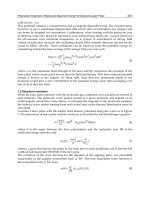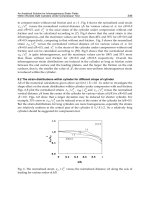Chapter 030. Disorders of Smell, Taste, and Hearing (Part 13) docx
Bạn đang xem bản rút gọn của tài liệu. Xem và tải ngay bản đầy đủ của tài liệu tại đây (13.52 KB, 5 trang )
Chapter 030. Disorders of Smell,
Taste, and Hearing
(Part 13)
Evoked Responses
Electrocochleography measures the earliest evoked potentials generated in
the cochlea and the auditory nerve. Receptor potentials recorded include the
cochlear microphonic, generated by the outer hair cells of the organ of Corti, and
the summating potential, generated by the inner hair cells in response to sound.
The whole nerve action potential representing the composite firing of the first-
order neurons can also be recorded during electrocochleography. Clinically, the
test is useful in the diagnosis of Ménière's disease, where an elevation of the ratio
of summating potential to action potential is seen.
Brainstem auditory evoked responses (BAERs) are useful in differentiating
the site of sensorineural hearing loss. In response to sound, five distinct electrical
potentials arising from different stations along the peripheral and central auditory
pathway can be identified using computer averaging from scalp surface electrodes.
BAERs are valuable in situations in which patients cannot or will not give reliable
voluntary thresholds. They are also used to assess the integrity of the auditory
nerve and brainstem in various clinical situations, including intraoperative
monitoring and in determination of brain death.
The vestibular-evoked myogenic potential (VEMP) test elicits a
vestibulocollic reflex whose afferent limb arises from acoustically sensitive cells
in the saccule, with signals conducted via the inferior vestibular nerve. VEMP is a
biphasic, short-latency response recorded from the tonically contracted
sternocleidomastoid muscle in response to loud auditory clicks or tones. VEMPs
may be diminished or absent in patients with early and late Ménière's disease,
vestibular neuritis, benign paroxysmal positional vertigo, and vestibular
schwannoma. On the other hand, the threshold for VEMPs may be lower in cases
of superior canal dehiscence and perilymphatic fistula.
Imaging Studies
The choice of radiologic tests is largely determined by whether the goal is
to evaluate the bony anatomy of the external, middle, and inner ear or to image the
auditory nerve and brain. Axial and coronal CT of the temporal bone with fine 1-
mm cuts is ideal for determining the caliber of the external auditory canal,
integrity of the ossicular chain, and presence of middle-ear or mastoid disease; it
can also detect inner-ear malformations. CT is also ideal for the detection of bone
erosion with chronic otitis media and cholesteatoma. MRI is superior to CT for
imaging of retrocochlear pathology such as vestibular schwannoma, meningioma,
other lesions of the cerebellopontine angle, demyelinating lesions of the
brainstem, and brain tumors. Both CT and MRI are equally capable of identifying
inner-ear malformations and assessing cochlear patency for preoperative
evaluation of patients for cochlear implantation.
Disorders of the Sense of Hearing: Treatment
In general, conductive hearing losses are amenable to surgical correction,
while sensorineural hearing losses are more difficult to manage. Atresia of the ear
canal can be surgically repaired, often with significant improvement in hearing.
Tympanic membrane perforations due to chronic otitis media or trauma can be
repaired with an outpatient tympanoplasty. Likewise, conductive hearing loss
associated with otosclerosis can be treated by stapedectomy, which is successful in
90–95% of cases. Tympanostomy tubes allow the prompt return of normal hearing
in individuals with middle-ear effusions. Hearing aids are effective and well-
tolerated in patients with conductive hearing losses.
Patients with mild, moderate, and severe sensorineural hearing losses are
regularly rehabilitated with hearing aids of varying configuration and strength.
Hearing aids have been improved to provide greater fidelity and have been
miniaturized. The current generation of hearing aids can be placed entirely within
the ear canal, thus reducing any stigma associated with their use. In general, the
more severe the hearing impairment, the larger the hearing aid required for
auditory rehabilitation. Digital hearing aids lend themselves to individual
programming, and multiple and directional microphones at the ear level may be
helpful in noisy surroundings. Since all hearing aids amplify noise as well as
speech, the only absolute solution to the problem of noise is to place the
microphone closer to the speaker than the noise source. This arrangement is not
possible with a self-contained, cosmetically acceptable device.
In many situations, including lectures and the theater, hearing-impaired
persons benefit from assistive devices that are based on the principle of having the
speaker closer to the microphone than any source of noise. Assistive devices
include infrared and frequency-modulated (FM) transmission as well as an
electromagnetic loop around the room for transmission to the individual's hearing
aid. Hearing aids with telecoils can also be used with properly equipped
telephones in the same way.









